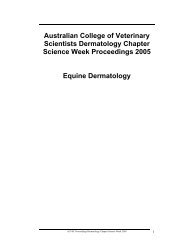Azathioprine and chlorambucil: mechanism of action and use in ...
Azathioprine and chlorambucil: mechanism of action and use in ...
Azathioprine and chlorambucil: mechanism of action and use in ...
Create successful ePaper yourself
Turn your PDF publications into a flip-book with our unique Google optimized e-Paper software.
monoalkylated product on the DNA str<strong>and</strong>. Repetition <strong>of</strong> this cycle ca<strong>use</strong>s cross-l<strong>in</strong>k<strong>in</strong>g <strong>of</strong> DNA. In the case<br />
<strong>of</strong> <strong>chlorambucil</strong>, two complementary str<strong>and</strong>s <strong>of</strong> DNA are cross-l<strong>in</strong>ked. 41 Cross-l<strong>in</strong>k<strong>in</strong>g <strong>of</strong> DNA prevents<br />
separation <strong>of</strong> DNA str<strong>and</strong>s for transcription <strong>and</strong> subsequent failure <strong>of</strong> transcription leads to apoptosis.<br />
Chlorambucil can also covalently bond to RNA <strong>and</strong> prote<strong>in</strong>s through a similar <strong>mechanism</strong>. 42<br />
Figure 4. Chemical composition <strong>of</strong> <strong>chlorambucil</strong><br />
Chlorambucil is considered cell cycle non-specific. Follow<strong>in</strong>g oral adm<strong>in</strong>istration, <strong>chlorambucil</strong> is<br />
rapidly <strong>and</strong> nearly completely absorbed from the gastro<strong>in</strong>test<strong>in</strong>al tract. It is highly prote<strong>in</strong> bound <strong>in</strong> plasma.<br />
The major route <strong>of</strong> metabolism is spontaneous hydrolysis, though <strong>chlorambucil</strong> is also metabolized <strong>in</strong> the<br />
liver to form phenylacetic acid mustard (active compound). Phenylacetic acid mustard is further metabolized<br />
to <strong>in</strong>active products which are excreted <strong>in</strong> the ur<strong>in</strong>e <strong>and</strong> faeces. 43<br />
Indications <strong>in</strong> Dermatology<br />
Human<br />
Table 1. Selected dermatologic diseases where <strong>chlorambucil</strong> has shown to be <strong>of</strong> benefit<br />
Neoplastic disease Pyoderma gangrenosum 44<br />
Cutaneous T cell lymphoma 45, 46 Behçet’s disease<br />
Sézary syndrome 46 Necrobiotic xanthogranuloma 49<br />
Cutaneous B cell lymphoma 50 Cutaneous sarcoidosis 51<br />
Non-neoplastic disease Sweet’s syndrome 52<br />
Pemphigus vulgaris 53 Bullous pemphigoid 54<br />
Pemphigus foliaceous 53 Dermatomyositis 55<br />
Veter<strong>in</strong>ary<br />
Table 2. Selected dermatologic diseases where <strong>chlorambucil</strong> may be <strong>of</strong> benefit<br />
Mast cell tumour 56, 57 Discoid lupus erythematosus 22<br />
Fel<strong>in</strong>e eos<strong>in</strong>ophilic granuloma complex 58 Systemic lupus erythematosus 22<br />
Pemphigus foliaceous 21, 22 Immune-mediated vasculitis 22<br />
Pemphigus vulgaris 21, 22 Cold agglut<strong>in</strong><strong>in</strong> disease 22<br />
Superficial pemphigus complex 21, 22 Urticaria pigmentosa 56<br />
Bullous pemphigoid 22 ? Cutaneous T cell lymphoma 59<br />
Adverse effects<br />
Haematologic<br />
Bone marrow toxicity is the most common side effect <strong>of</strong> <strong>chlorambucil</strong> therapy. It may be mild <strong>and</strong><br />
transient, or severe <strong>and</strong> progressive. Myelosuppression is manifested by anaemia, leukopenia <strong>and</strong><br />
thrombocytopenia. Leukocyte nadir may take 7-14 days, with recovery from 7-28 days. Severe pancytopenia<br />
may take months to years to achieve full recovery. 43<br />
Gastro<strong>in</strong>test<strong>in</strong>al<br />
Na<strong>use</strong>a <strong>and</strong> vomit<strong>in</strong>g are frequent side effects <strong>of</strong> alkylat<strong>in</strong>g agent adm<strong>in</strong>istration, <strong>in</strong>clud<strong>in</strong>g<br />
<strong>chlorambucil</strong>. Na<strong>use</strong>a has been reported with<strong>in</strong> m<strong>in</strong>utes <strong>of</strong> adm<strong>in</strong>istration <strong>of</strong> the drug <strong>in</strong> humans, but may<br />
takes hours or days to become cl<strong>in</strong>ically apparent. 42 In general, traditional antiemetics are poorly effective <strong>in</strong><br />
controll<strong>in</strong>g vomit<strong>in</strong>g with these agents. Intractable na<strong>use</strong>a <strong>and</strong>/or vomit<strong>in</strong>g may require hospitalization <strong>and</strong><br />
symptomatic therapy. A dose reduction should be considered <strong>in</strong> severe cases.<br />
Hepatotoxicity has been documented <strong>in</strong> humans <strong>and</strong> animals with alkylat<strong>in</strong>g agents, 42, 43, 60 however<br />
<strong>chlorambucil</strong> has a higher safety marg<strong>in</strong> than other alkylat<strong>in</strong>g agents (e.g. lomust<strong>in</strong>e) thus fatal hepatoxicity<br />
with this drug is rarely reported <strong>in</strong> the human literature <strong>and</strong>, to the authors’ knowledge, has not been reported<br />
<strong>in</strong> the veter<strong>in</strong>ary literature.<br />
47, 48<br />
52
















